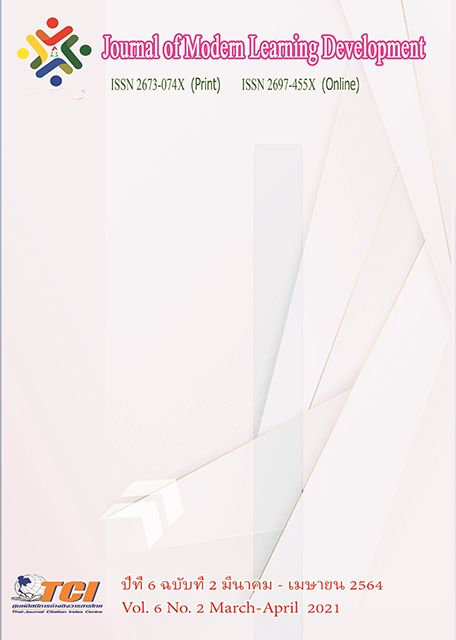Factors Related to Cricket Protein Adoption in Australia
Main Article Content
Abstract
The objectives of this research were to 1) study the factors related to consumers’ adoption of cricket protein in Australia and 2) present the approach to increasethe adoption of cricket protein among consumers in Australia. This study was a quantitative research. The sample group included 400 people, aged 20-44, resided in Perth, Australia who were selected by simple random sampling. A questionnaire was used as the tool for the data collection, and the statistics for the data analysis were an exploratory factor analysis.
According to the research findings:
1) In regard to the factors of the consumers’ adoption of cricket protein in Australia, there were six factors: attitude, perceived behavioural control, subjective norm, food neophobia, food format from cricket protein, and consumers’ acceptance.
2) The approach to encourage the adoption of cricket protein among consumers in Australia include building a positive attitude and awareness byproviding knowledge and information to guarantee the safety of consuming crickets and crickets are good source of protein for health. Furthermore, nutritionists, environmentalists, and campaigners should be encouraged to become influencers recommending, the consumption of cricket protein to public. In addition, processed foods from crickets can also lessen the fear of eating crickets; for example, cricket powder, cricket pasta, cricket chips, cricket energy bars, bakery, or other types of cricket protein, thus increasing the likelihood of adoption.
Article Details
References
กัลยา วานิชย์บัญชา. (2557). การวิเคราะห์สถิติ. (พิมพ์ครั้งที่ 16). กรุงเทพมหานคร: สำนักพิมพ์แห่งจุฬาลงกรณ์มหาวิทยาลัย.
ชุตินันท์ สงวนประสิทธิ์. (2562). รู้ยัง! ยา ขนมที่กินวันนี้อาจมีส่วนผสมของแมลงอยู่ก็ได้ แล้วธุรกิจแมลงโต
แค่ไหน?. ออนไลน์. สืบค้นเมื่อ 17 ตุลาคม 2562. แหล่งที่มา: https://brandinside.asia/insect-business-future/
Bartrim, J. (2017). Insect farming and consumption in Australia -opportunities and barriers. Zoologist, 39 (1), 26-30.
Chang, H.P., Ma, C.C. and Chen, H.S. (2019). Climate Change and Consumer’s Attitude toward Insect Food. International Journal of Environmental Research and Public Health, 16 (9), 1606.
Department of Home Affairs, Australian Government. (2019). Chapter 4 Australia in Now. Online. Retrieved April 29, 2020, from: https://immi.homeaffairs.gov.au/citizenship-subsite/files/thai-non-test.pdf
Gmuer, A., Guth, J.N., Hartmann, C. and Siegrist, M. (2016). Effects of the degree of processing of insect ingredients in snacks on expected emotional experiences and willingness to eat. Food Quality and Preference, 54, 117-127.
Hartmann, C. and Siegrist, M. (2017). Consumer perception and behaviour regarding sustainable protein consumption: A systematic review. Trends in Food Science & Technology, 61, 11-25.
Kauppi, S.M., Pettersen, I.N. and Boks, C. (2019). Consumer acceptance of edible insects and design interventions as adoption strategy. International Journal of Food Design, 4 (1), 39-62.
Lensvelt, E.J.S. and Steenbekkers, P.A. (2014). Exploring Consumer Acceptance of Entomophagy: A Survey and Experiment in Australia and the Netherlands. Journal Ecology of Food and Nutrition, 53 (5), 543-561.
Mancini, S., Sogari, G., Menozzi, D., Nuvoloni, R., Torracca, B., Moruzzo, R., et al. (2019). Factors Predicting the Intention of Eating an Insect-Based Product. Foods, 8 (7), 270-282.
Sekaran, U. & Bougie, R. (2013). Research Methods for Business. (6th ed). Hoboken, NJ: John Wiley & Sons.
Sogari, G., Bogueva, D. and Marinova, D. (2019). Australian Consumers’ Response to Insects as Food. Agriculture, 9, 108-116.
Sogari, G., Menozzi, D. and Mora, C. (2017). Exploring young foodies’ knowledge and attitude regarding entomophagy: A qualitative study in Italy. International Journal of Gastronomy and Food Science, 7, 16-19.
Sogari, G., Menozzi, D. and Mora, C. (2018). The food neophobia scale and young adults’ intention to eat insect products. International Journal of Consumer Studies, 43, 68-76.
The Population Expert. (2020). Greater Perth Five year age groups. Online. Retrieved June 11, 2020. From: https://profile.id.com.au/australia/five-year-age-groups?WebID=290
Webb, C. (2018). Does it bug you? Edible insects on the menu at Royal Melbourne Show. Online. Retrieved May 2, 2020. From: https://www.theage.com.au/national/Victoria /does-it-bug-you-edible-insects-on-themenu-at-royal-melbourne-show-20180923-p505j6.html
Wilkinson, K., et al. (2018) Australian Consumers’ Awareness and Acceptance of Insects as Food. Insect, 9 (2), 44.
Yamane, T. (1973). Statistics: An Introductory Analysis. (3rd ed). New York: Harper and Row.


